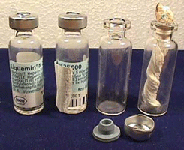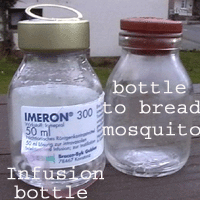These small containers are useful materials for your experiments.
The teacher opens the glass and plastic bottles, rinses them and desinfects bottles and closures by cooking in a pressure cooker.
The wet bottles and closures are kept in a plastic bottle which is cut before your work starts.
What to do
Replace the lables after cleaning and drying.
What you need
empty injection bottles (ampoule) s5 mL (Liquemin Roche) and infusion bottles 50 mL (IMERON Bracco-Byk Gulden), plastic dropper bottles 5 or 10 mL (by a nurse or new: Großhandel für Apotheken-Bedarf), Leukosilk for labelling, scissors, tissue paper, soap water.
Experiment
* Left: Liquemin ampoules are most useful for a huge number of experiments.
Liquemin is made of Heparin - a substance made in our liver-
preventing blood from glotting in the vessels.
Liquemin is injected to patients following operations. A clinic collects the empty bottles
* Remove the label after opening and desinfecting them in a pressure cooker. Re-label with Leukosilk.
* Middle: Repeat the same procedure with infusion bottles.
* Wash bottles, closures and stoppers with fresh water again.
* Right: Plastic dropper bottle re-labled and re-used as container for concentrated sulfuric acid.
Results
You have made lockable containers, a micro spirit burner and weights for your scale from empty bottles.
 ...
... ...
...